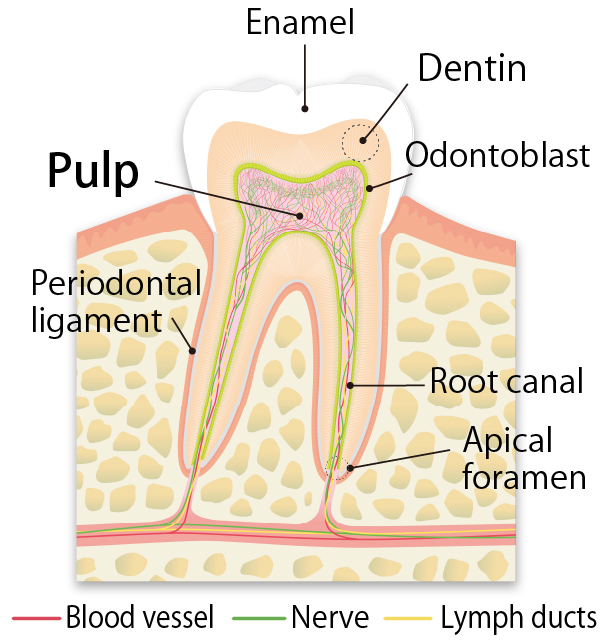About dental pulp (“the nerve of the tooth”)
Dental pulp (tissue) is a collection of nerves, blood vessels, and lymphatic vessels in the center of the tooth, and is commonly called the “nerve of the tooth.”
It is connected to body tissue at the root of the tooth. Its main role is to keep teeth strong by sensing pain and providing moisture and nutrients to each tooth.
【Examples of the roles and functions of dental pulp】
・Supply nutrients and moisture to teeth, and keep teeth strong and white
・ Help permanent teeth to grow (within a few years after eruption)
・Early detection of tooth decay and periodontal disease by sensing pain
・ Have innate immunity against bacteria and prevent the advance of tooth decay
・Have the ability to regenerate dentin
【Color and texture of dental pulp】
Color: Normally light pink
Texture: Soft, gelatinous consistancy
(Dental pulp in teeth with pulpitis due to the advance of tooth decay may turn black in color and lose its functionality and elasticity.)

Since pulp is usually not visible, many people may not know what it looks like or what it does.
But dental pulp supports our teeth and overall health from behind the scenes.
What are dental pulp stem cells?
Dental pulp stem cells are stem cells that exist in the dental pulp of our teeth.
*Stem cells: Special cells that have the ability to differentiate into cells of various tissues and replicate (cells that are the same as themselves).
Stem cells are found everywhere in our bodies, including cord blood, bone marrow, and adipose tissue.
In particular, dental pulp stem cells are protected by hard enamel, so they are less susceptible to external stimuli and less likely to suffer damage to their genetic makeup.
In addition, it has been found that dental pulp stem cells are more likely to differentiate into nerves and blood vessels than other stem cells.

The world’s first dental pulp regenerative treatment
The pulp of a tooth with advanced tooth decay, or one injured in an accident or sports-related injury is removed, root canal is cleaned, and prepared for nerve regeneration by transplanting dental pulp stem cells and associated medicine.
This treatment was approved in Japan in 2020. It is an advanced treatment, and has become a popular topic worldwide.
The differences from conventional treatments are as follows.

Conventional treatments
When a tooth begins to decay, it is the tooth enamel that dissolves first. This eventually progresses to the inside of the tooth, and reaches the pulp. It will begin to sting when hot or cold food or drinks touch the tooth, and you will feel a sharp or throbbing pain (pulpitis).
For teeth with advanced tooth decay, the usual treatment is to remove the pulp (pulp extraction) and fill the tooth with an artificial material such as cement (root canal treatment / artificial filling).
When the nerve is removed, pain signals do not reach the brain, and you do not feel any pain. But the pulp’s function of delivering nutrients to the tooth is also lost, which can cause discoloration and fractures (broken tooth).
If the tooth decays again after the nerve is removed, decay may progress unnoticed. When it reaches the root of the tooth, you may suddenly suffer severe pain.
If tooth decay progresses further, then the tooth may eventually have to be removed.
Dental Pulp Regenerative Treatment
Dental pulp regenerative treatment is a treatment that regenerates the pulp (nerve) from which existing pulp has been extracted—instead of filling the tooth with an artificial material—and reduces the risk of requiring tooth extraction.

Transplanting stem cells and restoring the nerve (dental pulp) of a healthy tooth allows nutrients to be distributed to the tooth again, which allows us to maintain our own strong teeth for a long time.
In addition, the dental pulp tissue also acts as a soft cushion, which can reduce the risk of tooth breakage in the event of a strong impact.
With the development of this treatment, it is now possible to choose a new treatment method for regenerating the nerve, instead of the conventional method of removing the nerve and filling it with an artificial material.
Going forward, we will continue to conduct further research and development with focus in treatment using the dental pulp stem cells of others (mainly close relatives) rather than just those of the patient.
